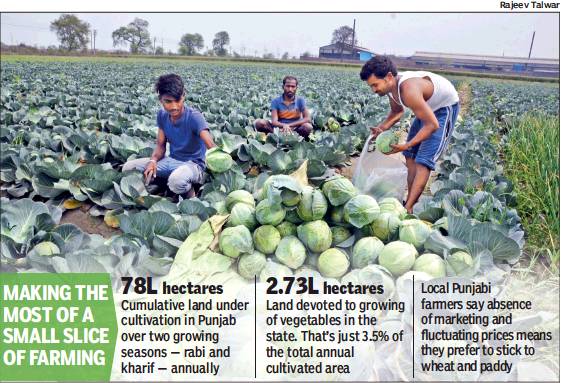Agriculture: Punjab (India)
This is a collection of articles archived for the excellence of their content. |
Vegetables
2019: migrant labourers cultivate

From: Neel Kamal & Shariq Majeed , Migrant hands are scripting a veggie success story in Punjab, April 4, 2019: The Times of India
They Mostly Started As Labourers For Big Cultivators, But Growing Crops Locals Tend To Avoid Yielded Rich Results
It has been a long journey for Shankar Lal in many ways. The 60-year-old native of Mainpuri in Uttar Pradesh was once a migrant labourer. Twice a year, during the harvest season, he would travel to Punjab and work in the fields for a month each before returning home. “Then I thought of settling down in Punjab and took land on lease to cultivate vegetables,” he said.
Lal has now made the village of Dhaner in Barnala district his home. His wife and he cultivate vegetables on a one-and-half-acre plot, paying rent of Rs 50,000 a year, and making a good living after selling their produce to a commission agent in the neighbouring town of Mehal Kalan.
There are many like Lal, all from outside Punjab, who have taken to vegetable cultivation and now own a chunk of the business in the state.
For decades, Punjab’s farmers have waited — often at railway platforms to catch them as soon as they get off their long-distance trains — for migrant labourers to help them sow and harvest wheat and paddy. There are now between 4 and 5 lakh migrant labourers, some seasonal and others residing in the state. It’s this community — almost all have a similar trajectory: they first came to Punjab as seasonal labourers and then decided to do some farming of their own — that has taken up the responsibility of supplying vegetables to Punjab’s households.
Jagdish Saikia has 14 acres of land on lease near Tapa Mandi on the Bathinda-Barnala highway. “Nearly 20 migrant families in the area are cultivating vegetables on leased land,” said the agriculturalist hailing from UP. Mohinderpal, also from UP, has settled down in Sanghera village in Bathinda and has leased two acres to grow cauliflower and peas. “Cultivating vegetables in Punjab pays better than doing odd jobs in UP,” he said.
Some distance away, Madan Sah, from Sitamarhi in Bihar, has rented 15 acres of land from a local farmer at Rs 50,000 per acre per year. “We grow cabbage, coriander, turnip, carrot and broccoli. If the crop is good, we get good rates in the Khanna and Ludhiana markets. We can even earn Rs 1 lakh per acre, but if the rate is poor, we suffer losses. However, growing vegetables is better than going for rice and wheat as a farmer earns a profit of only about Rs 25,000 per acre and the crop takes six months to grow,” Sah explained.
The story of Ganesh Prashad, 52, from Muzaffarpur in Bihar, is quite spectacular. He worked as a labourer for 20 years before finding the courage and confidence to become a farmer himself. “I have been growing vegetables for a few years on 15 acres rented from a local landlord. Vegetables take a short time to grow but need a lot of care. I work for 16 hours a day, water the crop, remove weeds and check for infections,” he said. “But it’s worth it. I can say, ‘I am the owner of this’.”
“We tried cultivating pulses and cereals, but absence of marketing and fluctuating prices of crops, including perishable items, made us stick to wheat and paddy. Free electricity also helped farmers stick to these crops, defeating efforts to diversify agriculture,” said Karnail Singh, who owns 15 acres at Sangat village in Bathinda. Another farmer, Gurbakhsh Singh, said lack of assured income from diversified crops meant farmers slowly focused only on wheat and paddy.
The affluence of Punjab farmers has also pushed them away from growing vegetables, which is labour intensive. “Farmers who own land don’t want to work hard. Now, paddy and wheat farmers have started renting out land because of restrictions on stubble burning,” said Prashad, who does his farming in Bhadla village of Khanna.
Some of the former migrant labourers now hire farm hands themselves. Chote Lal, from Bihar’s Sitamarhi district, has taken 14 acres of land on rent at Ajnali village of Mandi Gobindgarh. The 26-year-old said three cycles of vegetables in a year fetch him good returns.
“Growing vegetables involves a lot of hard work compared to cereals. But it can also pay off. We hire three or four labourers to help in the field. There are around 60 migrant labourers in the Khanna and Mandi Gobindgarh areas who have started growing vegetables,” said Lal.
Migrant labourers, according to MS Sidhu, professor of economics and sociology at the Punjab Agriculture University, are involved in occupational diversification in the real sense. “They are slowly becoming a part of the state’s economy,” added Sidhu.